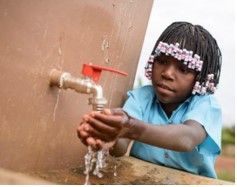Speeches Shim
BACKGROUND
The 29 million Mozambicans are served by approximately 1,640 primary level health facilities. Due to inadequate investment in routine maintenance and upgrades many of these facilities are in a poor condition and lacking essentials such as water, functioning sanitation systems, safe medical waste disposal and electricity. A lack of access to safe water and adequate sanitation, and poor hygiene practices creates the environment for an alarmingly high prevalence of diarrhea throughout the country. Furthermore, 16 percent of all deaths in Mozambique can be attributed to inadequate WASH practices.
PROGRAM DESCRIPTION
The activity works with decentralized government partners to improve the quality of WASH infrastructure in health facilities. Infrastructure works include WASH repairs, extensions or construction of water and sanitation systems based on assessments by qualified engineers. These facility improvements are being done by local private sector contractors based on the results of a public procurement process. The activity also supports the increased use of key hygiene behaviors through the development and/or revision of health center protocols on key WASH infection control behaviors. To ensure that the new facility water and sanitation infrastructures maintain a high level of sustained functionality, the activity strengthens institutional capacity by providing training on the use and maintenance of the new systems.
EXPECTED RESULTS/IMPACTS
The activity expects three interrelated results:
- Increased availability of functional water and sanitation infrastructure in health facilities;
- Increased use of health-promoting WASH practices at the health facilities;
- Improved management of health facility water and sanitation infrastructure, including improved MOH planning and monitoring of WASH services.


Comment
Make a general inquiry or suggest an improvement.